Panasonic TH42PZ80 is the third plasma HDTV from the world’s largest plasma flat screen manufacturer we’ve reviewed in as many months. The Panasonic TH42PZ80 offers true high definition 1920 x 1080 screen resolution over the HD-ready PX80 range, but lacks the “Intelligent Frame Creation” and “24p Real Cinema” motion compensated frame interpolation (MCFI) technologies found on the TH42PZ85B. Let’s see if this plasma television can help Panasonic complete a hat trick of “Highly Recommended” awards from HDTVTest in first-half of 2008.
<!-- google_ad_client = 'pub-2887677957235196'; google_ad_slot = '4990177225'; google_ad_width = 336; google_ad_height = 280; //-->
Note: The specific model we tested was the Panasonic TH42PZ80B (which denotes the 3-pin-plug British version), but the terms TH42PZ80 and TH42PZ80B will be used interchangeably throughout this review.
While sporting the same glossy black bezel with inscriptions of “Viera” on the top left and “Panasonic” at the bottom centre, what distinguishes the Panasonic TH42PZ80 from the PX80 and PZ85 series is a silver protrusion resembling an upper lip that spans the entire width of the frame at the bottom of the panel. Sandwiched between this and the bottom border of the bezel are a pair of TV speakers, an LED indicator and some infrared/ light sensors. On the protrusion itself you can find a central flap that flips up to reveal some control buttons and connection ports (including a HDMI input and an SD card slot).
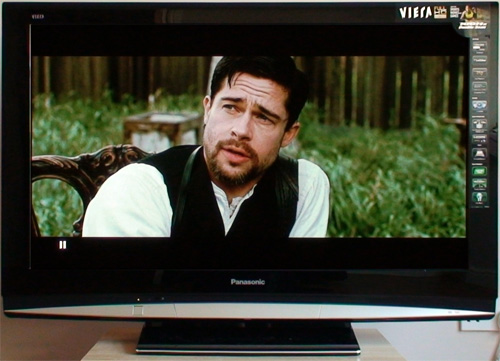
Otherwise, the Panasonic TH42PZ80 shares similar design characteristics to the TH42PZ85: a wedge-shaped pedestal stand; some cooling fans (though 1 less than the PZ85) and a pair of recessed handgrips at the back of the panel; and high overall build quality.
Unfortunately one of the three HDMI inputs is located at the front (under the central flap) of the Panasonic TH42PZ80, which may well mean the inevitable presence of an unsightly cable should you need to use all three HDMI ports.
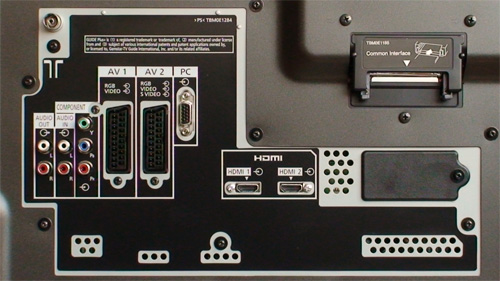 |
| Rear: 2 x HDMI, VGA, component, 2 x Scarts, CI slot, aerial, audio outs |
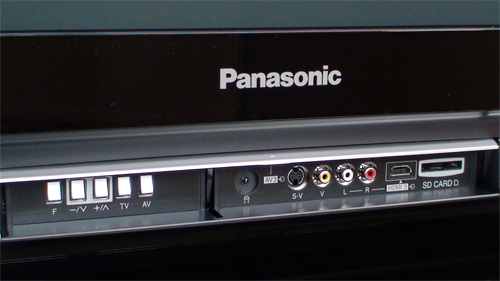 |
| Front: control buttons, headphone, Svideo, composite, HDMI, SD card slot |
Except for the understandable omission of [Intelligent Frame Creation] in the user menu, the on-screen menu, EPG and infrared remote control that comes with the Panasonic TH42PZ80 plasma television are essentially the same as those found on the TH42PZ85B. Viewers with sensitive ears may pick up the slight whir of the cooling fans, or power/brightness-related plasma buzzing, but assuming you sit more than 6 feet away from the screen, these background noise should be adequately drowned by normal TV volume.
Although post-calibration settings may vary from unit to unit, our Panasonic TH42PZ80 review sample needed no further adjustment (not that there were many picture controls available inside the user menu to start with) other than changing [Viewing Mode] to “Cinema” and [Colour Balance] to “Warm” to achieve the following greyscale results:
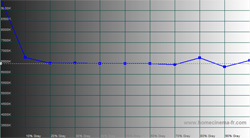 | 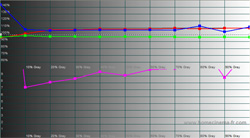 |
| [Colour Balance] “Warm” CCT | [Colour Balance] “Warm” RGB tracking |
Both red and blue values were higher than ideal, but they sort of neutralised each other to give a 6500k-ish correlated colour temperature (CCT). Make no mistake though, delta errors (dEs) remained around 8. Most people probably can’t see the difference in real-life viewing, but if you wish to reduce the dEs below the 4 threshold, you’ll have to venture into the service menu (and risk voiding your warranty) to adjust the RGB cuts and gains.
Following our recent “What Is Gamma” article, we thought it’d be enlightening to include the gamma graphs of the Panasonic TH42PZ80:
 | |
| Luminance vs input signal | Gamma vs input signal |
Overall gamma on the Panasonic TH42PZ80 after calibration was just a touch below 2.0, which means that the picture would exhibit brighter (perhaps too bright) shadow detail and slightly reduced punchiness/ “pop” compared to the 2.2 ideal. We would have appreciated the inclusion of a gamma control in the user menu to deal with this issue, but to be fair a gamma of 2.0 will probably irk only the staunchest of videophiles.
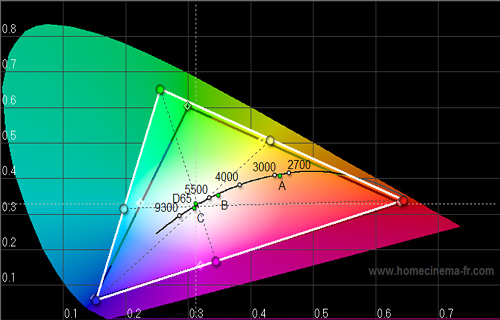 |
| Panasonic TH42PZ80 CIE chart with reference to HD Rec. 709 |
No surprises here… the colour gamut of the Panasonic TH42PZ80 was almost identical to those on the PX80 and PZ85, with an oversaturated and bluish green primary point and slightly oversaturated reds. The [Colour] control in the [Picture] submenu was of little use as it affected both colour saturation and intensity in no uncertain terms, whereas [Tint] was greyed out unless presented with an NTSC video signal (the UK uses PAL system).
| Dead pixels | None |
| Screen uniformity | Perfect |
| Overscanning on HDMI | 0% with [Picture Overscan] set to “Off“ |
| Blacker than black | Passed |
| Black level | Excellent |
| Black level retention | Stable |
| Primary chromaticity | Average; green oversaturated and bluish |
| Scaling | Soft |
| Video mode deinterlacing | Good; effective jaggies reduction |
| Film mode deinterlacing | Failed 3:2/ 2:2 cadence in all resolutions |
| Viewing angle | Excellent (> 150°) |
| Motion resolution | 1080 |
| Digital noise reduction | Good at baseline |
| Sharpness | Defeatable edge enhancement |
| Image retention | Mild during the first 200 hours |
| Posterization | Mild, though worse with poor source |
| Phosphor trails | Yes; severity depends on individual susceptibility |
| 1080p/24 capability (PS3) | Accepts 1080p/24 video signal; no telecine judder |
| Input lag | On par with Samsung F96 |
Any comments on the image quality of a Panasonic plasma HDTV (high definition television) must surely begin with praise of its black-level performance and shadow detail revelation. Although still marginally lighter than those found on Pioneer Kuros, the inky blacks on the Panasonic TH42PZ80 left us in absolute enthrallment while watching The Assassination Of Jesse James By The Coward Robert Ford on Blu-ray. The cinematographically stunning nighttime train robbery scene could have quite easily murdered any lesser flat screen panel, yet the Panasonic TH42PZ80 effortlessly depicted the contrast between light and dark (e.g. the train light flickering past the dark woods, and Jesse Jame’s silhouette against the blinding illumination) and nuances in the deep shadows with commanding finesse and authority.

The colours inside the movie itself are intentionally attenuated at source in keeping with the historical period, and so the Panasonic TH42PZ80 was not to be blamed for the picture’s lack of depth and dimensionality. Flesh tones appeared natural enough, but the mild green inaccuracies could be picked up by perceptive viewers during numerous shots of the wheat fields.

Unleashed by setting [Picture Overscan] to “Off“, the true HD 1920×1080 native screen resolution on the Panasonic TH42PZ80 lent incredible detail to certain camera shots in the film, for example facial close-ups of Jesse James (Brad Pitt) where we can appreciate his jawline stubble, and the crow’s feet around his perpetually anguished and penetrating blue eyes. The Panasonic TH42PZ80 flat screen plasma also handled 1080p/24 video signal from the PS3 flawlessly, betraying no sign of telecine judder in sweeping pans of the breathtaking Missouri landscape.
Without the aid of edge enhancement, the scaling quality on the Panasonic TH42PZ80 plasma HDTV was mediocre at best, so perhaps there is a case for sprinkling in a touch of overenhancement (by increasing [Sharpness] a couple of notches) for standard-definition content. We were also disappointed by no improvement in posterization in spite of the full HD native screen resolution, although these usually only reared their ugly heads with poor source (low bit-rate, highly compressed broadcast material) and during fade-in/ fade-to-black.
Given the lack of any meaningful film mode deinterlacing on the Panasonic TH42PZ80, it is advisable to feed the television with progressive video signals (i.e. let your external device perform the relevant pulldown) when watching film-based material (movies, American dramas like CSI) if you want to avoid seeing various deinterlacing artefacts (line twitter, moire, etc.)
The combination of LCD-trouncing blacks, LCD-equalling brightness, almost blur-free motion handling and full high definition screen resolution brought Gran Turismo 5: Prologue to gloriously photorealistic 1080p fruition on the Panasonic TH42PZ80 plasma television. Input lag was non-existent, either measured objectively or assessed subjectively as we hugged the racing lines on the tracks.
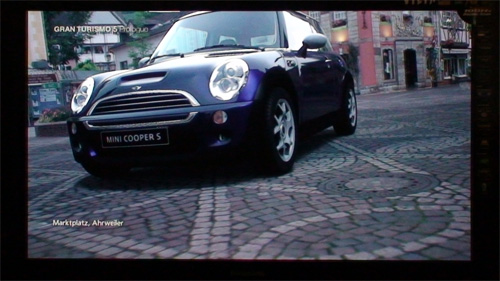
As with all plasmas, there remained the risk of permanent screenburn, but this could be minimised by taking appropriate precautions and avoiding lengthy non-stop gaming sessions. Phosphor trails/ green flashes might pose a problem for susceptible viewers with high retinal persistence; we did not witness any.
Delivering excellent black level, revealing shadow detail, fluid motion, detailed resolution and natural colours, performance-wise the Panasonic TH42PZ80 is fundamentally a PZ85 minus the [Intelligent Frame Creation] technology which–truth be told–we’re not too keen on for various reasons. If you’re not overly bothered about the aesthetics of the television itself (the PZ85 probably edges the PZ80 in this regard) or the intrusive positioning of the third HDMI input, then the Panasonic TH42PZ80 would almost certainly represent a better bang for your buck than the PZ85 series.

<!-- google_ad_client = 'pub-2887677957235196'; google_ad_slot = '0693194791'; google_ad_width = 336; google_ad_height = 280; //-->